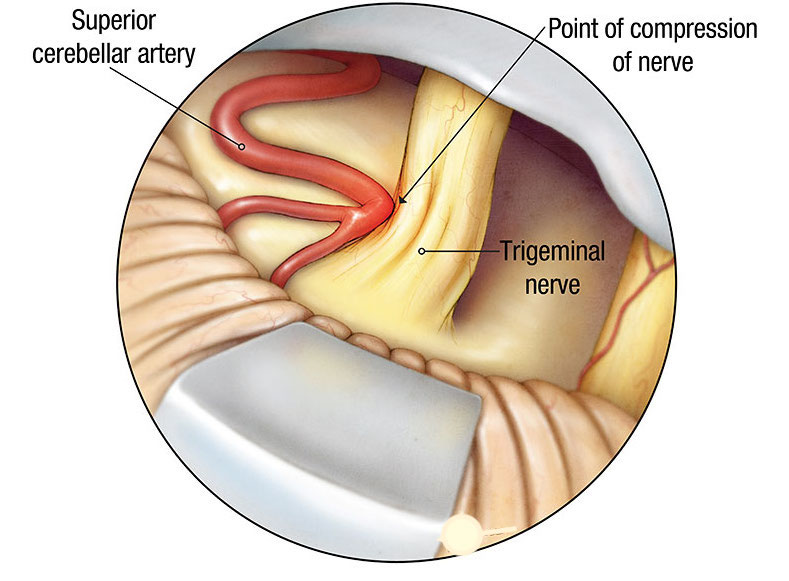BALLOON COMPRESSION FOR TRIGEMINAL NEURALGIA
Indications
Trigeminal Neuralgia

Procedure
In Balloon Compression procedure a balloon is inflated inside the skull to compress the trigeminal ganglion in such a way as to disrupt pain signals from getting through to the brain and help with pain relief.
The procedure is carried out in the Radiology theatre/operating theatre.
The procedure is performed under general anaesthesia under fluoroscopic guidance. X-ray pictures are taken throughout the procedure to help direct the needle to the correct place. A needle is inserted through the cheek under x ray until it just passes through the foramen ovale (a hole in the base of skull, through which the nerve comes out of skull). A catheter (with small balloon at the tip) is then advanced through the needle and the balloon is slowly inflated. The entire procedure takes only 30 minutes. The balloon is deflated and then withdrawn along with the needle. Dressing is then applied to the cheek. Although the procedure itself only takes 30 minutes you may be admitted for an overnight stay to make sure there are no problems.


Special Instructions
Minimum of six hours of fasting is required before the procedure but clear instructions will be given to you with regards to this before your admission. You will be offered a drink after the procedure when you have come back to the ward from recovery. Take your usual medication and bring your medications with you. Patients taking warfarin/ Clopidogrel/ Aspirin will be given individual information as these medications need to be stopped few days before procedure.
Side Effects And Complications
It is usually a very safe procedure but is associated with very rare risks as any other invasive procedure. The side effects which are common but not serious are:
- mild discomfort at the site of the injection; this should last no longer than 48 hours However if the pain is severe or you feel unwell you should consult your own us
- You will experience numbness of the face, tongue or throat which gradually diminishes. Your face may feel swollen to you but it will look normal in the mirror. Some patients do not like this numbness.
Jaw weakness is very common but rarely troublesome and usually settles in a couple of months. The side effects which are serious but not common are:
- Three out of one hundred patients who have this procedure stand a chance of having infection of the brain (Meningitis)
- One out of fifty patients who have this procedure stands a chance of having bleeding in the brain.
- One out of one hundred patients who have this procedure can have visual disturbance or dryness of the eye on same side.
- Anesthesia dolorosa where you may be left with troublesome numbness of the face and continuous pain. It is a rare but reported complication.
- Death & serious catastrophe has also been reported but are extremely rare.
Procedures
- EPIDURAL STEROID BLOCK ( TFESI, CAUDAL, INTERLAMINAR )
- CERVICAL EPIDURAL NEUROPLASTY
- INTRAARTICULAR FACET BLOCKS
- MEDIAL BRANCH RFA FOR FACETOGENIC PAIN
- THIRD OCCIPITAL NERVE BLOCKS AND RFA
- C0-C1 and C1-C2 BLOCKS
- OCCIPITAL NERVE BLOCKS AND RFA
- SACROILIAC JOINT BLOCKS and RFA
- GASSERIAN RFA FOR TRIGEMINAL NEURALGIA
- BALLOON COMPRESSION FOR TRIGEMINAL NEURALGIA
- INTRAARTICULAR SHOULDER PROCEDURES
- PROLOTHERAPY
- PRP THERAPY
- GENICULAR NERVE RFA FOR KNEE PAIN
- LUMBAR SYMPATHECTOMY FOR LOWER LIMB ISCHEMIA & CRPS
- T2-T3 GANGLION NEUROLYSIS FOR UPPER LIMB ISCHEMIA AND CRPS
- STELLATE GANGLION BLOCKS AND RFA
- TRIGGER POINT INJECTIONS
- INTRARTICULAR TMJ PROLOTHERAPY
- KNEE JOINT INJECTIONS INCLUDING VISCOSUPPLEMENTATION
- CELIAC PLEXUS BLOCKS AND NEUROLYSIS
- SUPERIOR HYPOGASTRIC PLEXUS BLOCKS AND NEUROLYSIS
- GANGLION IMPAR BLOCK AND RFA